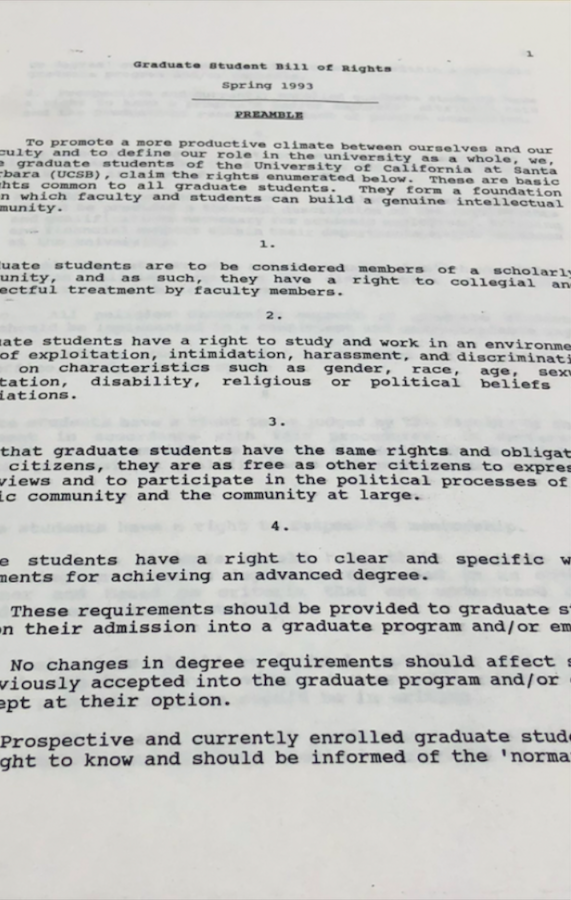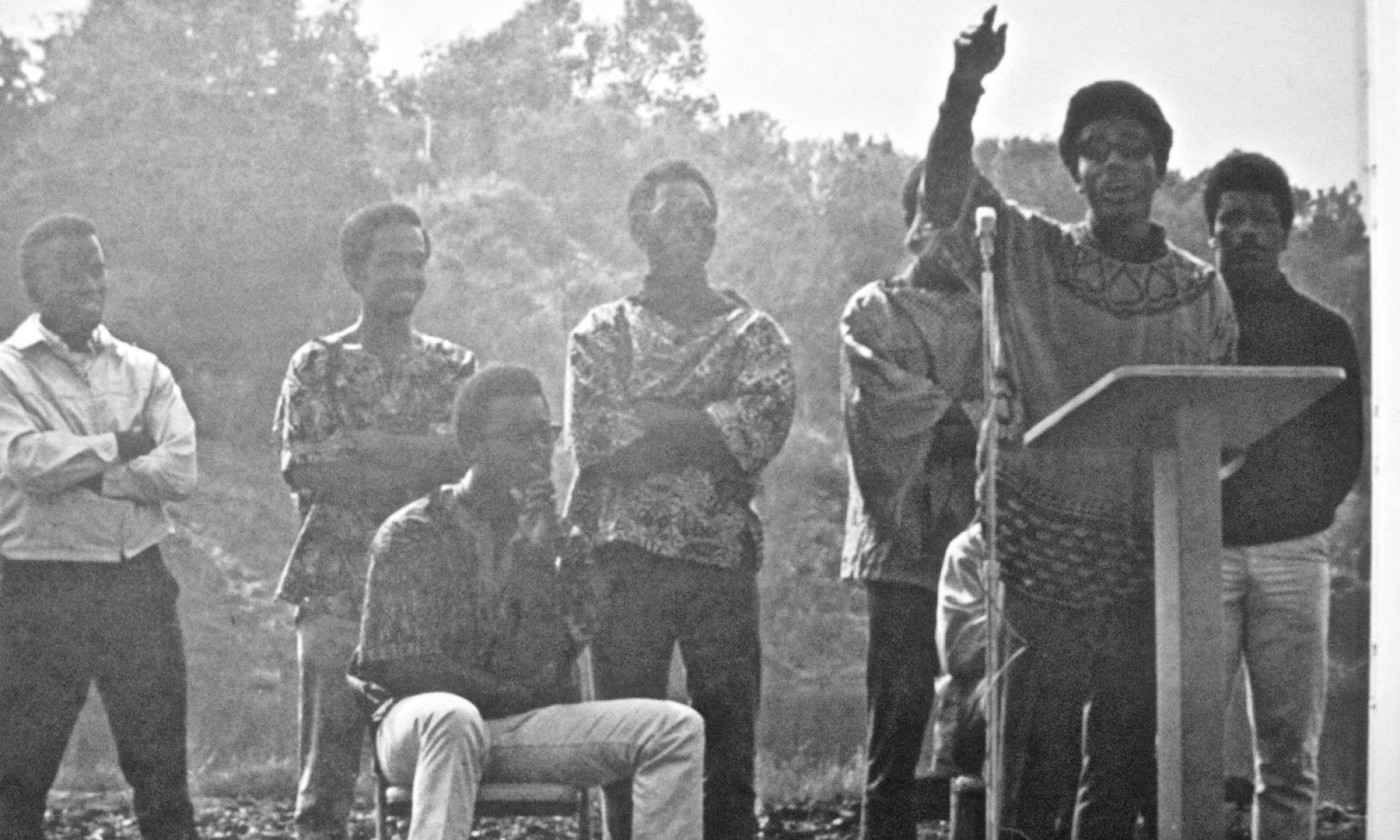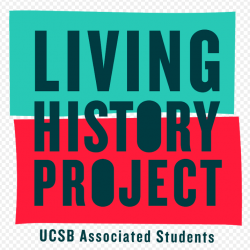By Jillian Wertzberger
1990s
Achieving Unionization
On June ninth of 1998, UCSB faculty received an email that their TAs, readers, and tutors would take part in a University of California system wide strike the following quarter. The UCSB Association of Student Employees, a graduate student union, had sent the email; while members had formed a state recognized union and had affiliated with the United Auto Workers (UAW), UC Regents still refused to recognize the collective bargaining rights of its members. But graduate students could no longer tolerate their working conditions; they were undervalued, underpaid, and overworked. So, graduate students across the UC system withdrew what power they had, their labor, in order to force recognition of their union.
Teaching assistants’ efforts before the 90s to negotiate with the UC were largely unsuccessful because TAs were considered apprentices, not employees. Apprentices, under the Higher Education Employer-Employee Relations Act (HEERA) of 1979 are students whose employment is related to their educational goals. This is significant because only employees were permitted to have collective bargaining rights. While graduate students challenged this legislation, the UC system spent millions of dollars in order to have the California Court of Appeals uphold the law. Even without the support of the UC, graduate students at UC Berkeley formed the Association of Graduate Student Employees (AGSE) in 1983. The AGSE later affiliated with the UAW in 1987 in order to expand its economic and organizational resources, and became the AGSE-UAW (the UAW at that point had expanded into nearly every sector of labor). However, it took UCSB until 1994 for graduate students to achieve the necessary 50% AGSE membership to be verified by California’s Public Employment Relations Board (PERB), a government agency that protects government workers’ rights. They quickly followed in UC Berkeley’s footsteps and created their own local chapter of the UAW for financial support and advising. Even with UAW affiliation and recognition by PERB, the UC Regents still refused to recognize the union. Finally, TAs across the UC system went on strike several times during the 1990s to demand that the UC regents recognize their union and give them a contract.
 [Graduate Student Bill of Rights 1993, GSA, Box 2] University of California, Santa Barbara, Graduate Student Records. UArch 13. Department of Special Collections, UC Santa Barbara Library, University of California, Santa Barbara.
[Graduate Student Bill of Rights 1993, GSA, Box 2] University of California, Santa Barbara, Graduate Student Records. UArch 13. Department of Special Collections, UC Santa Barbara Library, University of California, Santa Barbara.
Achieving Recognition
1998 – Prepare to Launch
During spring quarter of 1998, graduate students authorized a strike for early December of the following school year. In order to demonstrate strong support, members of the AGSE-UAW campaigned to achieve high member turnout on the strike authorization vote. The union set a quorum to ensure that half of all members must be present for the vote to prove to the UC that it had a wide base of support. Leading members held meetings and conducted phone campaigns in order to encourage fellow graduate students to vote for the strike. In the end, 87% of union members (about 500 out of the 600 members who voted) decided to go on strike in order to force the UC system to recognize their union. Ricardo Ochoa, the President of the AGSE, declared in an email to UC faculty that the union had shown “great restraint” in their previous communications with the UC. The union met with chancellors, launched letter writing campaigns, and instigated two day “rolling strikes” in the 1996-1997 school year instead of a system wide shutdown like the one proposed for 1998. However, the UC refused to take action.
The Big One
In fall quarter of 1998, graduate students on all eight campuses went on a “walkout” strike during finals week in order to force UC recognition of their union. Undergraduate support for the strike was surprising. In late November, the Daily Nexus issued a staff editorial in support of the strike, deeming it “justifiable” and calling on other undergrads to support the strike. The editorial stated that unionized graduate students would improve undergraduate students’ education by relieving stress for graduates and providing more enthusiastic TAs for sections.
The following day, the Nexus published two letters calling on students to support the strike. One letter, written by the AGSE-UAW, powerfully stated that when TAs are “overworked,” undergrads are “undertaught,” and touted the strike’s endorsement by Associated Students. The letter concluded by encouraging readers to contact Chancellor Yang and tell him to avoid the strike by immediately recognizing the union. The other letter, written by sociology TA Glyn Hughes reiterated that the strike was for the betterment of both graduate and undergraduates, and encouraged students to contact the UC President, Richard Atkinson.
Show Time
Beginning December 1, TAs at all UCs went on strike. The strike meant that participating union members would not grade papers or exams, or hold office hours or sections until the strike ended. Grad students picketed peacefully outside Davidson Library in order to draw undergraduate attention who they hoped would support their cause as an appreciation of the work TAs do for undergrads. However, administrators such as Vice Chancellor David Sheldon and many TAs believed the strike was disruptive and damaging to both graduate and undergraduate academics.
An “FAQ” sponsored by the UC in the December 3rd edition of the Daily Nexus offered the UC’s perspective on the issue. The Office of the Dean of the Graduate Division detailed the recently created Task Force on Graduate Student Support and the compensation packages of teaching assistants. The Dean maintained the position that TAs did not qualify as employees and that many of their complaints, such as compensation and workload, were either unjustified or able to be addressed through existing channels such as Graduate Advisors. Graduate student Mary Raven also said she did not support the strike in a letter to the Nexus editor because she also believed that issues could be handled through the chancellor and the Graduate Division.
 (Webb, Dec. 1998, Daily Nexus)
(Webb, Dec. 1998, Daily Nexus)
After a week of gridlock, State Assembly Speaker Antonio Villaraigosa and Senate President Pro Tem John Burton directed the UC and the UAW into a 45 day “cooling off period,” which began December 7. However, the UAW had not informed strikers that it had met with state legislators or UC representatives, and grad students were surprised to hear that the strike was off. As a result, factions formed within the AGSE-UAW union itself as many grads tried to break from the UAW. Fault lines deepened after members learned they did not have the democratic rights outlined in the UAW constitution until they were recognized by the UC. Therefore, the UAW could control meetings with the UC to negotiate a contract.
1999
Then, in March, the UC was forced to recognize the collective bargaining rights of graduate students. The need came after the Public Employee Relations Board (PERB) reexamined the responsibilities of TAs in the perennial court case Regents of the University of California v. Association of Graduate Student Employees. PERB ruled that graduate students should be considered employees, not apprentices. Because not every graduate student became an educator, their work as TAs was often not related to their educational goals. Therefore, as employees, they were entitled to collective bargaining rights.
However, the union still had to elect representation. PERB necessitated that each union needed leadership in order to negotiate a contract, but up to that point, leaders had been hand-picked by the UAW. Many TAs felt concerned about the influence of the UAW since the ASGE had affiliated with it and the lack of democracy that had been crucial to the grassroots efforts of the original ASGE. Nevertheless, in June, graduate students elected 184-134 (a low voter turnout), the UAW as their exclusive bargaining agent. The UAW soon held elections for the contract bargaining team: eight graduate students whose most electable qualities were that they were still willing to work with the UAW. However, these members resigned when the UAW moved to represent the whole UC system in contract negotiation and forced UCSB graduates into a “one size fits all” contract for all eight UCs; this included giving up the right to strike. There was no one left to work with the UAW at UCSB, but negotiations still continued without UCSB graduate representation.
2000
That summer, the UAW combined all UC graduate student unions into Local 2865, which bargained on behalf of all the campuses. The union negotiated the historic first contract for graduate students, although to many it seemed a hollow victory. The contract had failed to secure increased health care benefits and only achieved a nominal pay raise, however, it had managed to secure a victory in binding arbitration and grievance. Additionally, graduate students who were not part of the union still had to pay about $13 per month in dues in order to negotiate and enforce contracts. However, this easy revenue stream also discouraged the UAW from responding to member grievances or from organizing workers. While the union was historic, UCSB graduate students became disillusioned with the UAW, and membership dropped to just 53 card carrying members by the following year.
Graduate students still feel the effects of the historic contract, especially the clause that forbade strikes. In 2019, graduate students at UC Santa Cruz began a strike which cannot be authorized by the UAW because it breaches the contract. Because of this, UCSC cannot receive legal or financial support from the UAW International, even though the strike has led to the arrest of over a dozen graduate students. However, union membership to the UAW Local 2865 has increased significantly since 2000; today, roughly 60% of TAs at UCSB are members. The local UAW has been critical in networking and rallying support for graduate student issues such as the UC- wide movement for a Cost of Living Adjustment.
Works Cited
[ASE/UAW Authorization Vote, Correspondence 1998-2001, Box 2] University of California, Santa Barbara, Graduate Student Records. UArch 13. Department of Special Collections, UC Santa Barbara Library, University of California, Santa Barbara.
Update on Graduate Strike at UC Berkeley. (1996, November 21). Retrieved February 18, 2020, from https://www.berkeley.edu/news/media/releases/96legacy/agse.htmlold
Our History. (n.d.). Retrieved February 17, 2020, from https://uaw2865.org/about-our-union/our-history/
The Call for Unionization. (1998, November 24). Daily Nexus, p. 6. Retrieved from https://alexandria.ucsb.edu/downloads/hq37vp893
TA Strike Helps Undergrads. (1998, November 25). Daily Nexus, p. 4. Retrieved from https://alexandria.ucsb.edu/downloads/9593tw35m
Hughes, G. (1998, November 25). Help with the Strike. Daily Nexus, p. 4. Retrieved from https://alexandria.ucsb.edu/downloads/9593tw35m
Webb, K. (1998, December 3). TA Strike to Proceed Until Demands Are Met. Daily Nexus, pp. 1,9. https://alexandria.ucsb.edu/downloads/z029p595f
Fletcher, R. (1998, December 3). TAing is Not a Required Position for Grads. Daily Nexus, p. 6. https://alexandria.ucsb.edu/downloads/z029p595f
Raven, M. (1998, December 3). TA Strike Doesn’t Have Full Support. Daily Nexus, p. 7. https://alexandria.ucsb.edu/downloads/z029p595f
Office of the Dean of the Graduate Division. (1998, December 3). Questions and Answers. Daily Nexus, p. 8. https://alexandria.ucsb.edu/downloads/z029p595f
Shah, A. (1999, January 11). Ruling recognizes collective bargaining rights. Daily Bruin. https://dailybruin.com/1999/01/10/ruling-recognizes-collective-b/
Boyd, K. (1999, March 26). Grad Student Union Finally Busts UC. Science Magazine. Retrieved from https://www.sciencemag.org/careers/1999/03/grad-student-union-finally-busts-uc
Childress, E. (1999, January 6). TAs Halt Strike Early; Students Given Break. Daily Nexus, pp. 1,8. https://alexandria.ucsb.edu/downloads/7d278v07q
Sullivan, R. (n.d.). Pyrrhic Victory at UC Santa Barbara: The Struggle for Labor’s New Identity. In Cogs in the Classroom Factory (pp. 91–116). Wesport, Connecticut: Praeger. http://richardsullivan.org/wp-content/uploads/2014/12/Sullivan-2003-Pyrrhic-Victory.pdf
Saltzman, G. M. (2000). Union Organizing and the Law: Part Time Faculty and Graduate Teaching Assistants. In NEA 2000 Almanac of Higher Education (pp. 43–55). http://www.nea.org/assets/img/PubAlmanac/ALM_00_05.pdf
Public Employment Relations Board, (1995, July 17), UC Regents v. Association of Graduate Students, UAW. https://perb.ca.gov/wp-content/uploads/decisionbank/A269H.pdf
Public Employment Relations Board, (1998, December 11), UC Regents v. Association of Graduate Students, UAW. https://perb.ca.gov/wp-content/uploads/decisionbank/1301H.pdf
Douglas-Gabriel, D. (2020, February 14). Graduate Strike at UC Santa Cruz Leads to Arrests. Washington Post. https://www.washingtonpost.com/education/2020/02/14/graduate-strike-uc-santa-cruz-leads-arrests/%3foutputType=amp

